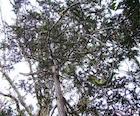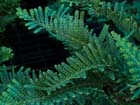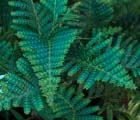
Tree in habitat; one of the photos posted on the endemia.nc page for L. neocaledonica [Daniel & Irène Létocart 2008.10.09].

Foliage on a sapling at the Royal Tasmanian Botanical Gardens [C.J. Earle, 2015.02.25].

Foliage on a sapling at the Royal Tasmanian Botanical Gardens [C.J. Earle, 2015.02.25].

Foliage on a sapling at the Royal Tasmanian Botanical Gardens [C.J. Earle, 2015.02.25].

Libocedrus austrocaledonica
Brongniart et Grisebach 1871
Common names
Taxonomic notes
Syn.: Stegocedrus austrocaledonica (Brongn. & Gris.) Doweld 2001. Type: New Caledonia, Mont Humboldt, B. Balansa 2503. Few studies have been performed on Libocedrus, but work to date suggests that the New Caledonian species are all closely related; see Libocedrus for discussion.
Description
A shrub or small tree to 6 m tall, usually with several stems branching near the base to form an open crown conforming to the Mangenot model (often narrowly conical in single-stemmed individuals). Bark red-brown, scaly, peeling in longitudinal strips. Twigs flattened, arranged on the branches in horizontally flattened, frond-like sprays. Facial and lateral leaves strongly distinct in both juvenile (see photo) and adult foliage; the lateral leaves are much larger than the facial leaves, dark green above with a broad, pale stomatal zone beneath. Facial leaves typically 1-2 mm long (visible portion); laterals 3-7 mm long and 1.5-3 mm wide; both facials and laterals larger on young than on adult trees. Tips of facial leaves generally do not touch base of next facial on the twig. Pollen cones 5-8 × 2-2.5 mm with 16-24 microsporophylls. Seed cones 6-8 × 3-5 mm, the spiny free tips of the bracts 7-10 mm long. Seeds about 6 mm long with a 9 mm wing. (Eckenwalder 2000, Farjon 2010).
Distribution and Ecology
New Caledonia, primarily in the southern province. Grows at elevations of 750 to 1,400 m, chiefly on strongly humic/acidic soils but not on ultramafics (which is a bit unusual for New Caledonia conifers); rainfall usually over 3,500 mm/yr and cloud cover nearly continuous. Grows in low, shrubby rainforest, commonly with the conifers Falcatifolium taxoides, Callitris pancheri, Pectinopitys ferruginea, Podocarpus spp., and occasional Araucaria humboldtensis; and with angiosperms such as species of Myrtaceae, Trimeniaceae, and Winteraceae, as will as with abundant ferns and many epiphytic mosses and lichens (Farjon 2010).
This map shows herbarium records of Libocedrus species native to New Caledonia. Red is L. austrocaledonica, yellow is L. chevalieri, and green is L. yateensis. Click on an icon for further information. Distribution data from GBIF (2020.03.30), edited to remove duplicates.
The species has a very narrow distribution (two small areas), and is threatened by mining and anthropogenic wildfire. The disjunct northern population is unprotected (Farjon 2010).
Zone 10 (cold hardiness limit between -1°C and +4.4°C) (Bannister and Neuner 2001).
Remarkable Specimens
No data as of 2023.03.03.
Ethnobotany
No known use by indigenous peoples, no known use in horticulture, and very uncommon in botanical gardens (Farjon 2010).
Observations
Protected populations occur in the Parq National de la Riviere Bleue (Farjon 2010), which seems a logical place to seek it out.
Remarks
The epithet refers to the species occurrence in southern New Caledonia (the northern population was discovered later).
Citations
Brongniart, Adolphe and Arthur Grisebach. 1871. Supplement aux coniferes de la Nouvelle-Caledonie. Bulletin de la Société botanique de France 18:130-141 (p.140). Available: www.biodiversitylibrary.org/item/8641#page/155/mode/1up, accessed 2016.11.26.
See also
Association Endemia, a site devoted to New Caledonian species. Has excellent photos, a range map, and other information. In French.
Farjon (2005) provides a detailed account, with illustrations.




